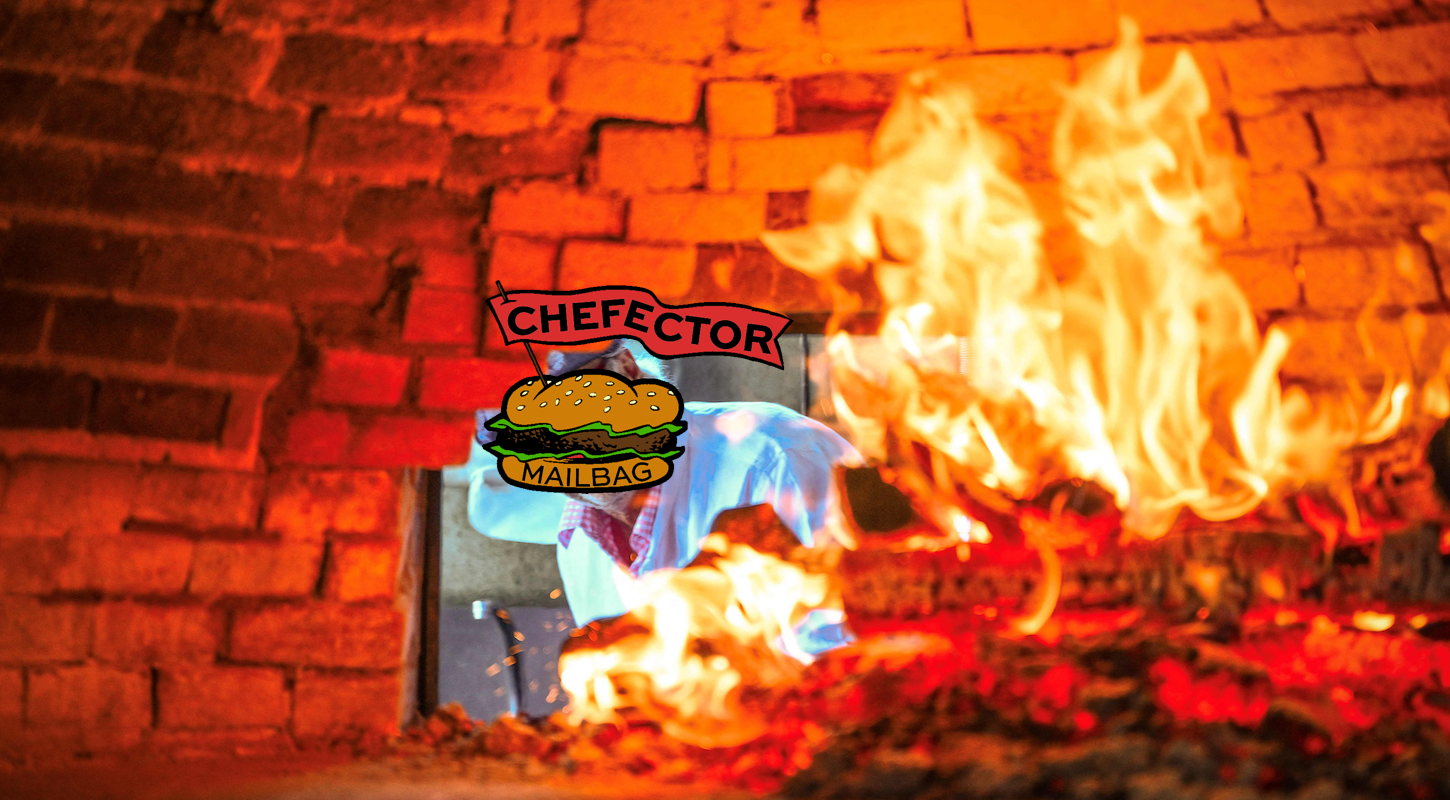Welcome to, uh, I dunno, let's call it Ask A Chefector, the column in which your internet food buddy (me) answers all of your questions about cooking and eating and food and pretty much anything else. Got questions about any of those things? Send me an email.
Tim:
I am still renting and, by looking at real estate prices for modest two-bedroom homes, it looks like I may be renting in perpetuity, and so I am unfortunately beholden to my past, current, and future landlords' decisions to furnish my various apartments with the cheapest electric ovens which exist. These ovens have ranges with the unlevel metal coils that heat unevenly both between coils (so a 6 on one coil is not the same heat as a 6 on another) and within a single coil.
Many recipes call for the use of real-deal HEAT for various processes (I believe I have seen you describe this as "shriekingly hot"). I have never worked in a restaurant kitchen so I really don't have a good reference for what this is supposed to mean. If I turn the knob on one of my cheap shit electric ranges to "High" it really does feel mind-bendingly hot, like if I were to stick a poor stick of asparagus on there that it would incinerate instantaneously. And so I feel I have always been too cowardly in my heat applications and limited myself to middling grey medium heat.
Do I need to risk ruining several meals worth of ingredients and just try to cook with this insanely high heat so I can calibrate my own sense of what "HOT" is supposed to mean (and perhaps find that 8 or 9 on the dial is the actually appropriate heat)? Or is this kind of heat actually pathetic baby heat compared to what recipes call for for searing, etc., and that I just need to work up the stones to be near it and to put my food near it?
Generally—generally!—speaking, the problem with home stoves vis-a-vis the heat needed to do good cooking, isn't that they produce too much heat, but rather the opposite.
Here is a story that maybe will illustrate something; anyway your question made me think of it and now I want to tell it, and it's my dang blog. Years ago, Defector's own Drew Magary and I went to the now-closed Brooklyn restaurant Talde to shoot an episode of our also now-closed Foodspin series. The commercial-grade gas wok stove in the kitchen of that place, when you turned it on, produced so much heat so quickly that it was actually kind of frightening to stand near, for me, an amateur cook familiar with the heat of normal home stovetops. The noise it made, a deep, ragged, furious, industrial roaring sound, seemed like something that belonged in, I dunno, a coke furnace. A smithy. The throat of a dragon. It sounded like it should be coming out of the back of a fighter jet. Then we fried some oysters in oil in a wok on that stove, and it was fine, and nothing came close to burning.
In any case! My point here is this: That you are dealing with an understandable but ultimately unnecessary fear of excess heat seems much more plausible to me than that you are dealing with a cheap electric stove that somehow puts out more heat than can be cooked with. It's fine! Don't waste any time feeling ashamed of this. You just aren't used to the serious shit yet. Real-deal heat is intimidating! It forces you to work quickly, and alertly, and it challenges you to recognize quickly, in a brief window of time, when your food is cooked to its optimal state and not yet burnt, and it makes smoke, and it requires you to be mindful of stuff like "the handle of this pan is as hot as the surface of the sun." It takes getting used to. Nobody has ever had the hang of it without first, y'know, getting the hang of it.
You can trial-and-error your way there, I think, building a sense of how long your stove takes to impart to your pan an appropriately high heat for searing, provided you accept up front that even the successes likely will involve smoke. Alternatively, you can simply buy a surface thermometer, a real category of product you can find online, and make things a lot easier for yourself. (I don't own one of these. Not out of principle or conservatism or whatever. I just own so many kitchen gadgets already.)
A very important thing to consider, also, is your cookware. Different types of cookware handle heat differently. A fully clad stainless-steel pan, for example (in simple terms, "fully clad" means the pan is composed of a layer or layers of either copper or aluminum, sandwiched between layers of stainless steel), will distribute heat very evenly over its surface, mitigating, if imperfectly, the weirdness of your heating coils. It will also retain its heat decently well, so that the temperature won't shoot all over the place when you put room-temperature foodstuffs into it. A good, thick cast-iron pan, in turn, won't distribute heat as evenly over its surface, and takes longer to heat up, but will retain its heat extremely well. Whereas a cheap-o nonstick pan, by contrast, will suck shit and will produce food that sucks, except for eggs, and you will always feel like there is some magical inherent good-at-cooking quality that you lack on a personal level, even though that's not true at all.
So here is my advice: If you can swing it, treat yourself to a nice, high-quality, fully clad stainless-steel pan. These come in three and five layers; the five-layer ones are pricier, and the three-layer ones are generally fine. This will cancel out much of the chaos energy of your weird electric stove, and make cooking with serious heat more rewarding.
Frigate13:
Once upon a time, I had a dream of becoming a Master Smoker & Griller. I bought a Weber smoker (the red vertical version, this was a long time ago) and a Weber Gas Grill. After a few attempts at smoking (long and boring—for me), and trying to be a gas grilling wizard, life intervened and I became an average, every-other-week-or-so simple griller (hamburgers, steaks, almost always with direct heat). I moved to Florida for a job in January 2020 (I know ... I appreciate your sympathy), to the Cape Canaveral area. Some time near the end of 2021, the sun and saltwater got to my Weber Gas Grill and literally ate off its leg. I have been without a grill since then.
However, a little itch is starting again, but this time I want to smoke and grill using my “shitty Weber kettle charcoal grill,” as I believe you used to call it [Editor's note: Close!]. I have rigged a bastard SnS smoker basket for my kettle, and installed a thermometer where it should be (near the air vent on the lid and over the food, instead of the opposite side, where Weber put it, which put it directly over the coals and caused inaccurate temperature readings).
Having reviewed the videos of probably more than 100 Youtube grilling masters (many of whom appear to be named Bubba or have overly-exaggerated southern accents), I am returning to the one guy from which I got some great grilling recipes and tips in the mid-2010s. I am hoping you can prescribe some “beginners” smoking and grilling recipes so I can get my feet back under me. I know if I start with a complex 12-hour smoking project right off the bat, I will lose interest and won’t revisit the kettle for months. I am hoping for shorter-term smokes and grills which will show me what I was missing, and won’t cause my mind to wander. The fate of my barbecuing future is in your hands, so ... no pressure!
OK so there are two answers here. The first and simpler is: Smoke some things that smoke quickly. Like dark-meat chicken quarters! These will be fully done and ready to eat within a couple of hours. Same with smoked trout, though I don't have a specific recipe for that. Just, uh, y'know ... smoke some trout filets. Dee-lish.
The second answer, requiring more explanation, is: Regardless of what various Smoke Lords may say, pretty much none of the normal meat-smoking endeavors have to be complex 12-hour projects. They might be lengthy undertakings! But they do not have to be complex or fussy, because you don't have to smoke the meat for all that time. You can get more than enough smoky flavor into even a huge frickin' pork shoulder by just smoking it for a few hours, tops, in your shitty charcoal kettle. By that point you will have accomplished all that you need smoke to accomplish; beyond that point, the only non-vanity reason to continue smoking the meat is if you particularly enjoy fussing over your charcoal snake or whatever.
Otherwise, wrap the meat, uh, item in a complete double layer of heavy-duty aluminum foil (to help it push through "the stall," the infamous phenomenon that occurs when the rate of evaporative cooling in the meat prevents the meat from getting any hotter, so it just sits there at the same dang temperature while all of its moisture steams away) and sock it in your regular-ass oven, at probably 250 degrees (less in the case of brisket), and cook it in there until it hits its target temperature. The normal oven will not need all the fussing of a smoker or a charcoal kettle. It will maintain its own temperature with no help from you.
That can still take a long time, in the case of huge meatwads like briskets and pork shoulders; these can still be the kinds of projects that you have to adjust one end or the other of your sleep schedule to accommodate. But even with these, the relatively fussy and complex part is over after just a few hours; the rest is mostly waiting, particularly if you have a reliable probe thermometer.
You can do, say, a couple racks of ribs this way, without having to reconfigure your whole dang weekend around the job. Given them an hour or two with the smoke, then probably not more than another oh, three minimally supervised hours in a 275-degree oven, and you will have some good ribs. No sweat.
Noe:
Do you have any tips for growing some stuff with the intention of having it on hand for cooking? We have scallions, chili peppers and cherry tomatoes. We tried to grow some beans, but that was a massive failure.
In my admittedly not all that extensive experience, unless you particularly enjoy the labors of gardening/farming for their own sake (or have the space to do a lot of planting), trying to grow the kinds of foods that take all dang spring and summer to grow and then get harvested pretty much all at once can be painfully unrewarding. Five dang months of fussing and watering and pruning and fertilizing and mitigating pests and arranging care for when you go to the beach, and then, like ... two meals' worth of eggplant. Bullshit!
For this reason, I do not waste my time with that stuff. Maybe if I had acres to work with, and a lot more free time, and the will or desire to learn how to properly can or jar stuff, I would grow, like, I dunno, friggin' artichokes. Then I could have fresh artichokes when they were done growing, but then also I could store some artichokes to have the whole rest of the year. But I am not toiling over a measly two dang artichokes in a couple of little pots on my deck for weeks or months just to have ... two measly frickin' artichokes. No way!
For me the most rewarding stuff to grow at home, by far, is the type of stuff that I can harvest a little of here and there throughout the entire growing season, without a whole lot of work. I am talking primarily about herbs, of course: Basil, parsley, chives, oregano, and mint (which you'll need to do in a container or else it will take over the surface of the earth) are all super easy to grow and will happily endure near-daily harvests of a few leaves for use in adding some fragrance to whatever you're cooking. (Cilantro is a bit more of a pain in the ass, at least in my hardiness zone—it is insanely, impossibly eager to bolt into Seed Mode—so most years I don't bother with it. And for whatever reason my thyme plants have tended to be scraggly and shitty. It's probably your fault.) This is because you do not need these plants to fruit before you can use them. They make leaves, and you pluck off some of the leaves, and you eat those leaves, while the little plant makes some more leaves. The circle of life, or whatever!
But I am also talking about: Indeterminate tomatoes! Indeterminate tomatoes are varieties of tomato plant that do not just stop growing at a certain point, make one batch of tomatoes, and then stop, but that will go on flowering and making tomatoes for weeks or months if properly cared for. You can get a lotta friggin' tomatoes out of indeterminate tomato varieties! Too many, in fact. The other thing that is nice about growing tomatoes is that in many places this is, by profound distance, the best and most reliable and possibly only way to have access to good tomatoes during Tomato Time.
Scrolling back up, I see that you were already growing tomatoes. Ah well. At least I got to write some stuff.
Ben:
I love a good summery pasta salad, especially on sunny, warm spring and summer days during a picnic. I can go to the store and usually get pretty good stuff, but I'm sure it's terrible for my health and has all kinds of extra ingredients that aren't good for me. Theoretically, I should be able to make a good pasta salad at home, but for some reason, it always just comes out bland. I don't know what I'm doing wrong. I just made some with a simple vinaigrette, farfalle, and a few veggies from the store like bell peppers, summer squash, red onion, and grape tomatoes. I even doubled the vinaigrette and it's still boring and mostly flavorless. Can you help me out there?
Ben, it pains me terribly to say this, not least because there is no way for me to pose this answer as a demonstration of deep and profound cooking expertise on my part, but the answer here almost certainly is: salt. You probably just need to use a little more salt, or use it more wisely.
Salt the water a little more heavily when you boil the pasta. Salt the vinaigrette a little more generously as you assemble it. If you're pre-cooking any of the vegetable stuff, salt it; if you're blanching it, blanch it in salted water. Consider adding some ingredients—thin slices of prosciutto or cured salami, say, or small cubes of cheese, or brined olives, or some flakes of good tinned fish—that will themselves add some saltiness, some punch, to the mix, to wake up your palate to all the other stuff in there. It's probably salt!
But maybe it isn't salt. You can try some other stuff. Add some grated raw garlic to the vinaigrette, or some anchovy paste, or a shitload of black pepper, or a few minor splashes of good fish sauce. (Yes, at least two of these things will also add saltiness, but that isn't all they'll do.) Toss the otherwise complete pasta salad with some fresh finely chopped herbs; alternatively, or maybe in addition, make the vinaigrette a day ahead with a small amount of dried herbs shaken into it. If you weren't doing any cooking to the vegetation, consider scorching it in a hot pan to draw out some depth of flavor (and sprinkling it with some salt). Double-check that the olive oil you're using in your vinaigrette is the real good, fruity, cold-pressed extra-virgin shit, and that the vinegar has some real character beyond tartness.
It's probably salt, Ben. It's probably just salt.
Jeff:
Cooking shows have told me over and over and over to let a piece of meat rest after cooking so that "the juices may redistribute, and not all run out as soon as you cut into it." Phrasing this as "redistributing" has always seemed odd to me. As if the juices have all anticipated where I will first cut and flooded that area. Now I know nothing about what's going on inside, but it seems like they're already all over the place in there (distributed), but maybe not all absorbed into the tissues in a way that would help the meat hold onto them after being cut into. Should we be saying "absorbed" instead of "distributed"?
Yeah the whole "redistributed" thing is, I think, a load of baloney. The reason to let the meat rest, I'm fairly confident, is because as it rests it will cool some, which will cause its juices not to "redistribute," and probably not to "absorb" (they're already absorbed, that's why they're in the meat instead of under it), but rather to congeal somewhat—the rendered-fat liquid, anyway—as the meat gets closer to room temperature. So that when you cut into the meat, the delicious greasy fat will not gush out, because it is not a hot watery liquid anymore. This is why instructions that tell you to rest the meat for 10 or 15 minutes aren't going far enough (including if I myself ever said to do that, which I can't recall right now). You should probably let it rest, under a loose foil tent, for close to half an hour!
To whatever extent the people telling you to rest your meat know that this is why to rest it, maybe they just think the word congeal, and the phenomenon to which it refers, are just a little grosser than they want their instructions to be. Personally I do not give a frig. This is enlightenment.






